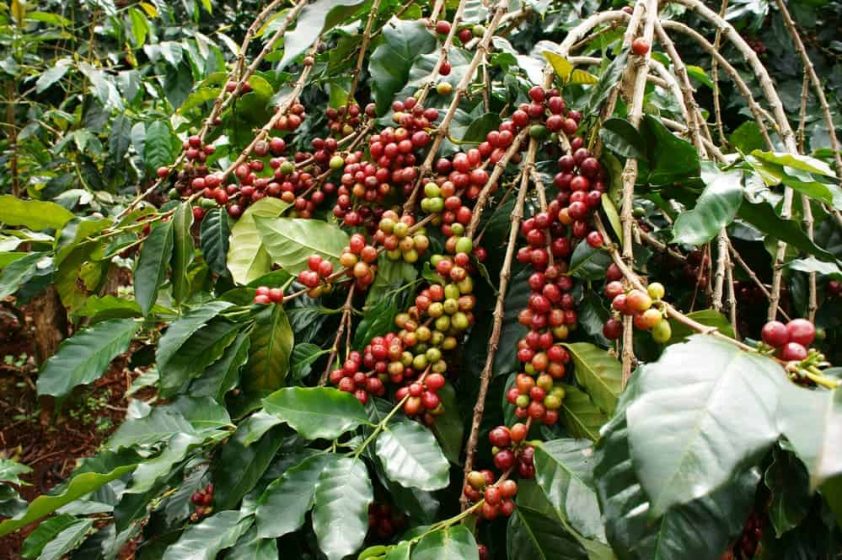Arabica
Arabica is the world’s most popular coffee. It makes up around 75% of the global coffee bean production.
Arabica beans tend to be milder and sweeter and are thus more palatable for the general public. This is likely one of the main reasons it is so popular.
Arabica coffee also tends to be more expensive because this bean type is relatively challenging to cultivate. They grow on delicate bushes that require high altitudes, consistently cold temperatures, and more time to grow.
Arabica thrives at high altitudes in the Tropic of Cancer at around 15-24°C (59-75°F).
It is usually grown in Africa and South America in countries such as Ethiopia—where it originated, Rwanda, Columbia, Costa Rica, Brazil, and Guatemala.
Depending on the location, method of cultivation, and country of origin, Arabica coffee ranges between being sweet or acidic.
It can be fragrant, tart, nutty, chocolatey or caramel. and it’s this variation and complexity of flavour that adds to the popularity.
Arabica is generally known for its berry-like quality that can be pleasantly acidic while also having hints of chocolate, nuts, and caramel.
The Arabica grown in African countries like Ethiopia tends to be full-bodied and sweet.
Robusta
As the second most popular coffee in the world, Robusta makes up roughly 20% of global coffee production and consumption.
Naturally lower in acidity, Robusta lacks the sweetness and brightness of Arabica. It is instead characterized by a sharper taste with a woody, earthy aroma.
This flavor combination might not appeal to everyone. But many coffee drinkers may prefer Robusta’s stronger flavor and its higher caffeine content. Robusta has 2.7% caffeine content compared to Arabica’s 1.5% caffeine content.
You can also purchase a blend that has both Robusta and Arabica.
These mixed blends are especially common among Italian roasters, who often believe that Robusta adds the finishing touch and depth to a coffee blend.
Robusta is often associated with poor quality because it is easier to cultivate and is thus sold at lower prices. It is also often used for instant coffee.
But none of this means that Robusta is objectively worse than Arabica. This is mainly a matter of taste preference.
Compared to Arabica, Robusta can be grown on more varied terrain and can withstand hotter temperatures.
Unlike the Arabica bush, Robusta coffee beans are grown on trees that can reach up to almost 10 meters (32 feet) high.

Robusta coffee is produced in many countries across Asia, Africa, and South America. Vietnam is the biggest producer of Robusta, followed by Brazil, Indonesia, and Uganda.
Liberica
As far as coffee stories go, the Liberica one is a little sad.
Towards the end of the 19th century, the plant disease ‘coffee rust’ killed off 90% of Arabica plants. The species was almost at risk of going totally extinct.
Coffee played a major role in the global economy at the time so halting its production and distribution would have dire consequences. So as the Arabica species was allowed time to bounce back, global cultivation focused on Liberica.
This species originated in Liberia, Africa—hence its name.
But Liberica was quickly introduced to various countries in Southeast Asia to better facilitate its mass production. For a short period, Liberica enjoyed worldwide popularity in its role as a substitute for Arabica.
We can trace Liberica’s downfall and Arabica’s comeback all the way back to political disputes between the Philippines and the United States of America.
During the coffee rust outbreak, the Philippines became one of the largest Liberica coffee suppliers to the rest of the world.
But when the Philippines declared that it wanted independence instead of being a U.S. territory, the U.S. responded with harsh trading sanctions and restrictions.
This effectively dethroned the Philippines as the world’s coffee supplier. In the meantime, the Arabica species was already recovered and well on its way to regaining its former popularity.
And today Liberica accounts for only 2-3% of globally produced and consumed coffee. But even so, Liberica is generally enjoyed, and like Arabica, it offers a variety of flavours.
Liberica is known to be fruity and floral. And is even often described as being sweeter than Arabica. Alternatively, Liberica can also have a woody and smoky flavour that some have even compared to tobacco.
Excelsa
If there was little known about Liberica, there’s even less known about its cousin Excelsa. This coffee bean species was discovered in Central Africa in the early 1900s.
Once recognized as a species in its own right, Excelsa was officially reclassified as a synonym for Liberica in 2006. This reclassification has led to quite the confusion among manufacturers and consumers alike.
Many use Excelsa and Liberica interchangeably, which has resulted in a lack of clarity regarding Excelsa’s data and statistics.
So it is estimated that Excelsa comprises roughly 2% or less of the world’s coffee bean production and consumption.
We have decided to discuss Excelsa separately in this article because it still has several features that distinguish it from Liberica.
Excelsa coffee beans deliver a “hybrid” taste. They are notorious for combining light roast traits (like tart notes and fruity flavors) with aromas and tastes typically associated with dark roasts (such as a woodier taste).
With such a rich depth of flavor within one coffee bean, it is a shame they’re not more readily available. However, you can still purchase Excelsa beans on global online platforms like eBay.
